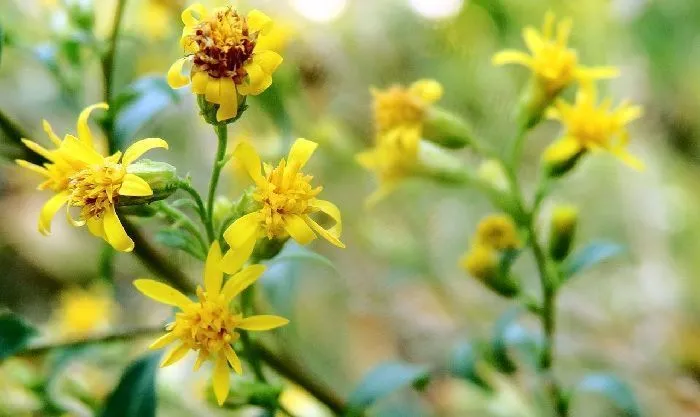It is known as goldenrod and it is not for less, because to Solidago virgaurea it is attributed great medicinal and healing properties for external and internal use. Its chemical composition is more than studied and today several Universities are fighting to discover new ways and means of obtaining a solution to the main diseases of the XXI century.
Therefore, we are going to make an introduction to its cultivation, we will know several of its properties and most interesting curiosities of this plant.
Table of Contents
Introduction to the Goldenrod Plant
Solidago virgaurea belongs to the family of Asteraceae, which we have once mentioned on this website and which brings together more than 23,500 species (including lettuce, sunflower, mugwort, daisy, etc.).
Specifically, goldenrod is a herbaceous characterized by an intense flowering and yellow color, which can even be combined ornamentally with other types of plants in xerophytic gardens or urban environments of low water consumption.
It usually grows on average up to 30-40 cm in height, but in soils rich in compost by decomposition of tree leaves it can grow above 50 cm in height.
The goldenrod plant can practically be found throughout Europe (except for very cold areas), being widespread in Spain and growing spontaneously in pine forests, forest clearings (looking for some more light), large areas of meadows and countryside and growing in rocky places.
However, its origins as a medicinal plant date from bibliographic reviews of Arab areas, and in Europe, from the thirteenth century onwards, with greater importance from the fifteenth and sixteenth century.
Since the beginning of the thirteenth century, as we have said, there is allusions to the use of the goldenrod for problems related to the urinary tract, kidney stones, nephritis and cystitis.
It was several centuries later, from 1600, when the benefits of Solidago virgaurea and solid information on its benefits was collected.
Different subtypes of this plant have been described, although no differentiated medicinal properties are attributed. There are subtypes that have a greater or lesser concentration in terms of chemical composition, and that have been selected in each of the scientific investigations.
- Solidago virgaurea subsp. alpestris (Waldst. & Kit.) Gremli
- Solidago virgaurea subsp. taurica (Judge.) Tzvelev
- Solidago virgaurea subsp. armena (Grossh.) Greuter
- Solidago virgaurea var. calcicola Fernald
- Solidago virgaurea subsp. macrorrhiza (Lange) Nyman
- Solidago virgaurea subsp. macrorrhiza (Lange) Nyman
- Solidago virgaurea subsp. Asian Kitam. ex Hara
- Solidago virgaurea subsp. caucasica (Kem.-Nath.) Greuter
- Solidago virgaurea subsp. gigantea (Nakai) Kitam.
- Solidago virgaurea var. insularis (Kitam.) Hara
- Solidago virgaurea subsp. jailarum (Judge.) Tzvelev
- Solidago virgaurea subsp. dahurica (Kitag.) Kitag.
- Solidago virgaurea subsp. lapponica (With.) Tzvelev
- Solidago virgaurea subsp. talyschensis (Tzvelev) Sennikov
- Solidago virgaurea subsp. turphosa (Woronow ex Grossh.) Greuter
Cultivation of Solidago virgaurea
Agronomically, it is not a medical plant susceptible to cultivation, although the same rule applies as in other related plants, where an adequate maintenance of the plant improves the production of its oils and the spectacularity of its flowering.
Simply and as a curiosity we leave some details of how the cultivation of goldenrod is carried out, since it can also be grown ornamentally or as garden decoration stony along with other related plants.

Climatic characteristics of goldenrod
The Goldenrod has been adapted for several centuries to the conditions of Europe and different areas of the Mediterranean. It withstands a wide range of temperatures and withstands well frosts not excessively intense. IGualmente, it can live in coastal environments with great sun exposure and intense heat in summer.
It is not convenient to plant it in areas where strong winds whip, as they can split their stems.
Its flowering occurs in the summer months (July – September), at which time it is when the plant is most sensitive to low temperatures.
It can be arranged in sunny environments and semi-shadow, although it prefers the former.
Soil and humidity conditions of Solidago
Solidago virgaurea it grows in all kinds of environments and no special conditions have been described. As long as it has minimal humidity conditions, it can grow spontaneously in stony, clayey and sandy soils.
However, it prefers soils with good drainage and deep. Those that have organic matter and are considered fertile produce greater flowering and better breeding conditions.
It is not recommended to provide fertilizers or at least limit the application of nitrogen, as it lengthens the stem of the plant excessively (it will grow above 50 cm) and can clash the arrangement of plants in the garden.
Multiplication
It reproduces easily from anemophilous pollination or by division of seedlings from autumn.
Pests and diseases
There is no in-depth study on pests and diseases affecting Goldenrod. Cases of mite attacks (spider mite) in summer and Aphid since spring, a very polyphagous insect that attacks almost all crops.
Medicinal properties of goldenrod
Chemical composition of Solidago virgaurea
Some of the chemical compounds that are part of this plant and that define its medicinal properties are the following:
- Flavonoids (isorramnetol, quercetol, glucorramnosides and kaempferol)
- Phenyl-carboxylic acid
- Salicylic acid and caffeic acid.
- Anthocyanosides (myocyanin, cyanide-3-diglucoside)
- Tannins (saponosides)
- Essential oils and monoterpenes
- Mucilages and inulins.
Antioxidant potential
Taken as an infusion, alone or in combination with other plants (lemon balm, chamomile, etc.) has vitamins and antioxidants that improve the digestive tract and have a diuretic effect.
Many plants of the Asteraceae family, such as dandelion, sunflower and daisies, have a fairly complete vitamin complex, such as vitamin A, C and E. In particular, vitamin E has great potential with antioxidant effects.
Its effect can be combined with other plants with antioxidant effects, such as those found in the medicinal plant milk thistle.
Fungal inhibition
Some of the essential oils of this plant reduce the reproduction of fungi and inhibit the development of different diseases of fungal origin, such as thrush, caused by the fungus Candida albicans.
For the treatment of diseases in the mouth, it is recommended to gargle with 40 grams of goldenrod flowers in 1 liter of water, under decoction of 10 min.
This remedy is also indicated to relieve the symptoms of canker sores in the mouth or sores.
Healing of wounds and burns on the skin
Great medicinal properties have always been attributed in the healing, topically of wounds, burns and scars.
Given the content in essential oils and mucilages, it can be used as a poultice from goldenrod oil to be used as a balm. In fact, it can be combined with other medicinal plants such as yarrow or St. John’s wort to potential the desired effect.
It is interesting to let the decoction of the Goldenrod rest in water for several hours, to get as many tannins as possible to be released.
Improvement of the urinary tract
The goldenrod has an interesting history of curing problems related to vegija infections and the urinary system. In fact, it has been considered as a suitable tool by the German health commission.
These qualities are due to the astringent and antiseptic properties it offers. Solidago virgaurea, improving the proper functioning of the kidneys, reducing inflammationit is of the urinary tract and problems derived with the vegija.
The flavonoids contents in the goldenrod also have diuretic functions, so it can be used by infusions when suffering from kidney stones, nephritis, cystitis or related diseases.

Are there any contraindications?
Currently, there are no known contraindications with the taking or external use of the Goldenrod. In long-term intakes, goldenrod can cause heartburn.
In patients taking hypertensive drugs, it is necessary to consult with the specialist doctor to define a combination between this plant and other drugs.
Very few cases of contact allergy have been diagnosed by the use of Soligado. Specifically rashes, rhinoconjunctivitis or bronchial asthma.
How are remedies prepared with goldenrod?
More important than knowing the medicinal properties of goldenrod is knowing how to prepare infusions, poultices and uses for topical and external use.
Goldenrod preparations for internal use
For an infusion of the volume of a common cup (200-300ml), introduce a tablespoon of coffee from its dried flowers. You can take between 2 and 3 cups a day, for example, if we suffer from kidney stone or problems derived with the urinary tract.
To prepare infusions of greater volume, in general 20 grams of goldenrod extract for every liter of water. It is boiled for 10 min and rested.
goldenrod preparations for external use
For external use, we will prepare poultices based on goldenrod oil, prepared by its flowers or leaves.
40 grams per liter of flower and leaf water are macerated for at least 24 hours. You can replace water with oil or increase the number of grams (from 40 grams to 60 grams). Apply to wounds, scars or burns using a poultice (bandage, compress or derivative).
Do you know more benefits of the medicinal plant Goldenrod?
